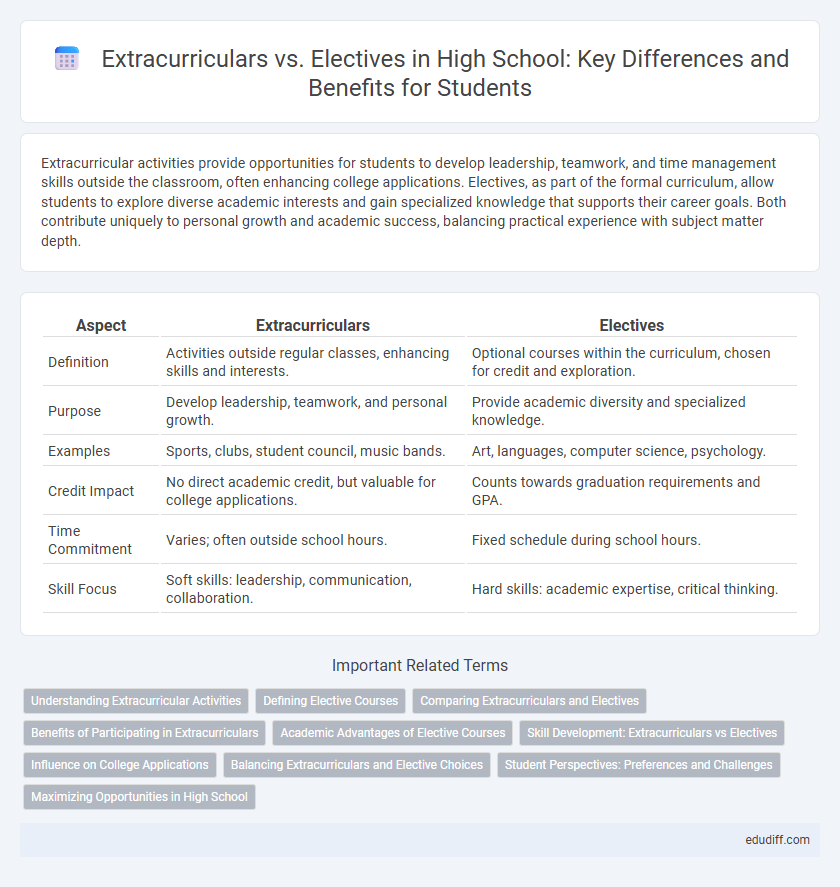Extracurricular activities provide opportunities for students to develop leadership, teamwork, and time management skills outside the classroom, often enhancing college applications. Electives, as part of the formal curriculum, allow students to explore diverse academic interests and gain specialized knowledge that supports their career goals. Both contribute uniquely to personal growth and academic success, balancing practical experience with subject matter depth.
Table of Comparison
| Aspect | Extracurriculars | Electives |
|---|---|---|
| Definition | Activities outside regular classes, enhancing skills and interests. | Optional courses within the curriculum, chosen for credit and exploration. |
| Purpose | Develop leadership, teamwork, and personal growth. | Provide academic diversity and specialized knowledge. |
| Examples | Sports, clubs, student council, music bands. | Art, languages, computer science, psychology. |
| Credit Impact | No direct academic credit, but valuable for college applications. | Counts towards graduation requirements and GPA. |
| Time Commitment | Varies; often outside school hours. | Fixed schedule during school hours. |
| Skill Focus | Soft skills: leadership, communication, collaboration. | Hard skills: academic expertise, critical thinking. |
Understanding Extracurricular Activities
Extracurricular activities in high school include clubs, sports, volunteer work, and arts programs that complement academic learning and develop social, leadership, and time-management skills. These activities enhance college applications by demonstrating student engagement beyond the classroom and fostering personal growth. Unlike electives, which are academic courses chosen within the curriculum, extracurriculars are voluntary and often take place outside regular school hours.
Defining Elective Courses
Elective courses in high school are academic classes students choose based on personal interests, contrasting with mandatory core subjects like math and science. These courses include options such as art, foreign languages, or computer programming, allowing students to explore diverse fields and develop specialized skills. Electives contribute to a well-rounded education and can influence college applications by showcasing unique talents and passions.
Comparing Extracurriculars and Electives
Extracurriculars in high school include activities outside the regular curriculum such as sports, clubs, and volunteer work, offering skills in teamwork and leadership. Electives are optional courses within the academic schedule that allow students to explore interests like art, music, or coding while earning credit towards graduation. Both play crucial roles, with electives enhancing academic breadth and extracurriculars fostering personal growth and social engagement.
Benefits of Participating in Extracurriculars
Participating in extracurricular activities enhances students' social skills, leadership abilities, and time management, contributing to personal growth beyond the classroom. These activities provide practical experiences that foster teamwork, responsibility, and creativity, which are highly valued by colleges and future employers. Engagement in sports, clubs, and volunteer work promotes a well-rounded high school resume, strengthening college applications and scholarship opportunities.
Academic Advantages of Elective Courses
Elective courses in high school enhance academic performance by allowing students to explore specialized subjects such as advanced mathematics, foreign languages, and science technology, which deepen subject mastery and critical thinking skills. These courses often align with college prerequisites, boosting college readiness and improving GPA through rigorous coursework tailored to student interests. By offering targeted academic challenges, electives foster intellectual growth and prepare students for diverse academic and career paths.
Skill Development: Extracurriculars vs Electives
Extracurricular activities foster soft skills such as teamwork, leadership, and time management through real-world experiences beyond the classroom, enhancing social and emotional growth. Electives contribute to skill development by providing specialized academic knowledge and practical abilities in areas like art, technology, or foreign languages within a structured curriculum. Combining both extracurriculars and electives creates a balanced skill set, promoting cognitive, interpersonal, and vocational competencies essential for college and career readiness.
Influence on College Applications
Extracurricular activities demonstrate a student's leadership, teamwork, and time management skills, often making applications more attractive to college admissions committees. Electives highlight academic interests and intellectual curiosity by allowing students to explore specialized subjects beyond core requirements. Balancing both extracurriculars and electives provides a holistic profile that showcases diverse talents and a well-rounded education, increasing competitiveness in college admissions.
Balancing Extracurriculars and Elective Choices
Balancing extracurricular activities and elective courses in high school enhances time management skills and provides a well-rounded educational experience. Prioritizing electives that complement career interests while engaging in extracurriculars fosters personal growth and academic success. Strategic selection ensures students develop diverse skills without compromising academic performance or personal well-being.
Student Perspectives: Preferences and Challenges
High school students often prefer electives that align closely with personal interests or future career goals, finding them more engaging and relevant to their academic growth. Extracurricular activities appeal to students seeking social interaction, skill development, and stress relief outside the classroom, yet balancing time between clubs, sports, and academics poses a significant challenge. Both options require students to prioritize commitments, with electives demanding academic rigor and extracurriculars requiring consistent participation, impacting overall student well-being and performance.
Maximizing Opportunities in High School
Extracurriculars and electives complement each other by broadening skill sets and enhancing college applications, with electives offering academic depth and extracurriculars providing leadership and teamwork experiences. Balancing both allows high school students to explore interests while developing time management and social skills vital for personal growth. Choosing a mix strategically maximizes opportunities, fostering a well-rounded profile attractive to universities and future employers.
Extracurriculars vs Electives Infographic

 edudiff.com
edudiff.com